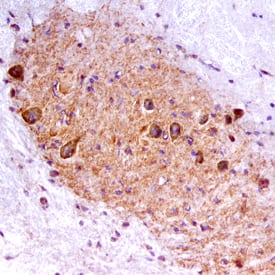Mouse IL-3 Biotinylated Antibody Summary
Asp33-Cys166
Accession # NP_034686
Customers also Viewed
Applications
Mouse IL-3 Sandwich Immunoassay
Please Note: Optimal dilutions should be determined by each laboratory for each application. General Protocols are available in the Technical Information section on our website.
Preparation and Storage
- 12 months from date of receipt, -20 to -70 °C as supplied.
- 1 month, 2 to 8 °C under sterile conditions after reconstitution.
- 6 months, -20 to -70 °C under sterile conditions after reconstitution.
Background: IL-3
Interleukin 3 is a pleiotropic factor produced primarily by activated T cells that can stimulate the proliferation and differentiation of pluripotent hematopoietic stem cells as well as various lineage committed progenitors. In addition, IL-3 also affects the functional activity of mature mast cells, basophils, eosinophils and macrophages. Because of its multiple functions and targets, it was originally studied under different names, including mast cell growth factor P-cell stimulating factor, burst promoting activity, multi-colony stimulating factor, thy-1 inducing factor and WEHI-3 growth factor. In addition to activated T cells, other cell types such as human thymic epithelial cells, activated mouse mast cells, mouse keratinocytes and neurons/astrocytes can also produce IL-3. At the amino acid sequence level, mature human and mouse IL-3 share only 29% sequence identity. Consistent with this lack of homology, IL-3 activity is highly species-specific and human IL-3 does not show activity on mouse cells.
IL-3 exerts its biological activities through binding to specific cell surface receptors. The high affinity receptor responsible for IL-3 signaling is composed of alpha and beta subunits. The IL-3R alpha is a member of the cytokine receptor super family and binds IL-3 with low affinity. Two distinct beta subunits, AIC2A ( beta IL-3) and AIC2B ( beta c) are present in mouse cells. beta IL-3 also binds IL-3 with low affinity and forms a high affinity receptor with the alpha subunit. The beta c subunits does not bind any cytokine but forms functional high affinity receptors with the alpha subunit of the IL-3, IL-5 and GM-CSF receptors. Receptors for IL-3 are present on bone marrow progenitors, macrophages, mast cells, eosinophils, megakaryocytes, basophils and various myeloid leukemic cells.
- Yokota, T. et al., 1984, Proc. Natl. Acad. Sci. USA 81:1070.
- Fung, M.C. et al., 1984, Nature 307:233.
- Miyatake, S. et al., 1985, Proc. Natl. Acad. Sci. USA 82:316.
Product Datasheets
Citation for Mouse IL-3 Biotinylated Antibody
R&D Systems personnel manually curate a database that contains references using R&D Systems products. The data collected includes not only links to publications in PubMed, but also provides information about sample types, species, and experimental conditions.
1 Citation: Showing 1 - 1
-
Response patterns of cytokines/chemokines in two murine strains after irradiation.
Authors: Zhang M, Yin L, Zhang K, Sun W, Yang S, Zhang B, Salzman P, Wang W, Liu C, Vidyasagar S, Zhang L, Ju S, Okunieff P, Zhang L
Cytokine, 2012-01-25;58(2):169-77.
Species: Mouse
Sample Types: Plasma
Applications: Luminex Development
FAQs
No product specific FAQs exist for this product, however you may
View all Antibody FAQsIsotype Controls
Reconstitution Buffers
Staining Reagents
Supplemental Cell Selection Products
Supplemental ELISA Products
Reviews for Mouse IL-3 Biotinylated Antibody
There are currently no reviews for this product. Be the first to review Mouse IL-3 Biotinylated Antibody and earn rewards!
Have you used Mouse IL-3 Biotinylated Antibody?
Submit a review and receive an Amazon gift card.
$25/€18/£15/$25CAN/¥75 Yuan/¥2500 Yen for a review with an image
$10/€7/£6/$10 CAD/¥70 Yuan/¥1110 Yen for a review without an image










